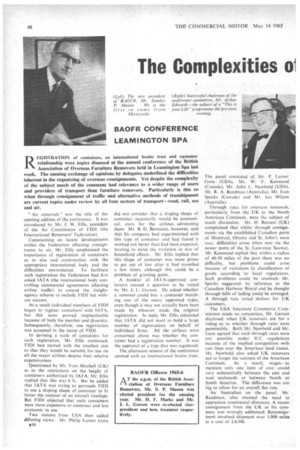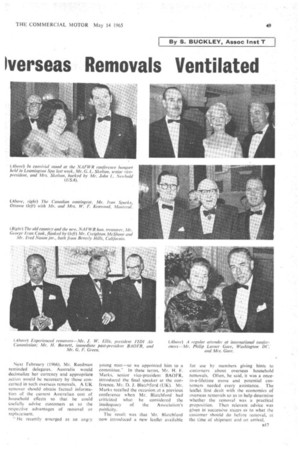The Complexities ol
Page 50

Page 51

If you've noticed an error in this article please click here to report it so we can fix it.
Iverseas Removals Ventilated
BAOFR CONFERENCE LEAMINGTON SPA
REGISTRATION of containers, an international brains trust and customer relationship were topics disussed at the annual conference of the British Association of Overseas Furniture Removers held in Leamington Spa last week. The ensuing exchange of opinions by delegates underlined the difficulties inherent in the organizing of overseas consignments. Yet despite the complexity or the subject much of the comment had relevance to a wider range of users and providers of transport than furniture removers. Particularly is this so when through consignment of traffic and alternative methods of transhipment are current topics under review by all four sectors of transport—road, rail, sea and air.
" Air removals " was the title of the opening address of the conference. It was introduced by Mr. J. W. Ellis, presickent of the Air Commission of FIDI (the International-Removers' Federation),
Commenting on recent developments within the Federation affecting consignments by air, Mr. Ellis emphasized the importance of registration of containers as to size and construction with the appropriate international body and the difficulties encountered. To facilitate such registration the Federation had first asked 1ATA (the international body controlling commercial agreements affecting airline traffic) to extend the freightagency scheme to include FIDE but without success.
As a result individual members of FIDI began to register containers with IATA, but this soon proved impracticable because of both the number and diversity. Subsequently, therefore, one registration was accepted in the name of FID1.
In devising a scale of containers for such registration, Mr. Ellis continued. F1DI had started with the smallest size so that they would be suitable for use on all the major airlines despite their relative expensiveness.
Questioned by Mr. Tom Mitchell (UK) as to the restrictions on the height of containers authorized by fATA, Mr. Ellis replied that this was 6 ft. But he added that TATA was trying to persuade FiDi to use a sloping shape of container to fit better the contour of an aircraft fuselage. But FIDE objected that such containers were more expensive to construct and less economic in use.
Two visitors from USA then added differing views. Mr. Philip Lamer Gore B16 did not consider that a sloping shape of container necessarily would be economical, even for the airlines advocating them. Mr. B. D. Bernstein, however, said thgt his company had experimented with this type of container and had found it worked out better than had been expected, bearing in mind the variation in size of household effects. Mr. Ellis replied that this shape of container was more prone to get out of line after it had travelled a few times, although this could be a problem of growing pains.
A booklet of I ATA-approved containers caused a question to be raised by Mr. J. I_ Gerson. He asked whether a remover could buy a container matching one of the many approved types. even though it may not actually have been made by whoever made the original registration. In reply Mr. Ellis reiterated that TATA did not want to hold a large number of registrations on behalf of individual firms. All the airlines were concerned about was whether the container had a registration number. It was the approval of a type that was registered.
The afternoon session of the conference opened with an international brains trust. The panel consisted of Mr. P. Lanier Gore (USA), Mr, W. F. Kellwood (Canada), Mr. •John L. Newbold (USA), Mr. 12. A. Reed-man (Australia), Mr. Ivan Sparks (Canada) and Mr. lan Wilson (Australia).
Through rates for overseas removals, particularly from the UK to the North American Continent, were ihe subject of much discussion. Mr. H. Burnett (UK) complained that whilst through consignments via the established Canadian ports of Montreal, Ottawa and St. John's were easy, difficulties arose when sent via the newer ports of the St. Lawrence Seaway. Mr. Kenwood replied that within a radius of 40-50 miles of the port there was no difficulty. but problems could arise because of. variations in classification of goods according to local regulations. Such problems could be resolved,. Mr. Sparks suggested. by reference to the Canadian Harbour Board and he thought through bills of lading could be arranged. A through rate saved dollars for UK customers.
The USA Interstate Commerce Cornmission made no concession, Mr. Gerson disclosed. when UK removers ask for a ruling as to whether through rates were permissible. Both Mr. Newbold arid Mr. Gore agreed that such through rate's were not possible under ICC regulations because of the implied competition with van lines over the American land routes. Mr. Newbold also asked UK removers not to forget the vastness of the American Continent. As a result, wages—to mention only one item of cost—could vary substantially between the east and west seaboards or between North or South America. The difference was too big to allow for an overall flat rate.
Art Australian on the panel. Mr. Reedman. also stressed the need to appreciate continental distances. A recent consignment from the UK to his company was wrongly addressed. Reconsignment involved shipment over 1.000 miles at a cost of EA300. Next February (1966), Mr. Reedman reminded delegates, Australia would decimalize her currency and appropriate action would be necessary by those concerned in such overseas removals. A UK remover should obtain factual information of the current Australian cost of household effects so that he could usefully advise customers as to the respective advantages of removal or replaement.
• ' He recently emerged as an angry young man—so we appointed him to a committee." In these terms, Mr. H. F. Marks, senior vice-president BAOFR, introduced the final speaker at the conference. Mr. D. 5. Blatchford (UK). Mr. Marks recalled the occasion,at a previous conference when Mr. Blatchford had criticized what he considered the inadequacy of the Association's publicity.
The result was that Mr. Blatchford now introduced a new leaflet available for use by members giving hints to customers about overseas household removals. Often, he said, it was a oncein-a-lifetime move and potential customers needed every assistance. The leaflet first dealt with the economics of overseas removals so as to help determine whether the removal was a practical proposition. Then relevant advice was given in successive stages as to what the customer should do before removal, at the time of shipment and on arrival.
BAOFR Officers 1965-6
A T the a.g.m. of the British Association of Overseas Furniture Removers, Mr. S. P. Mason was elected president for the ensuing year. Mr. H. F. Marks and Mr. J. L. Gerson were re-elected vicepresident and hon. treasurer respectively.




















































































































